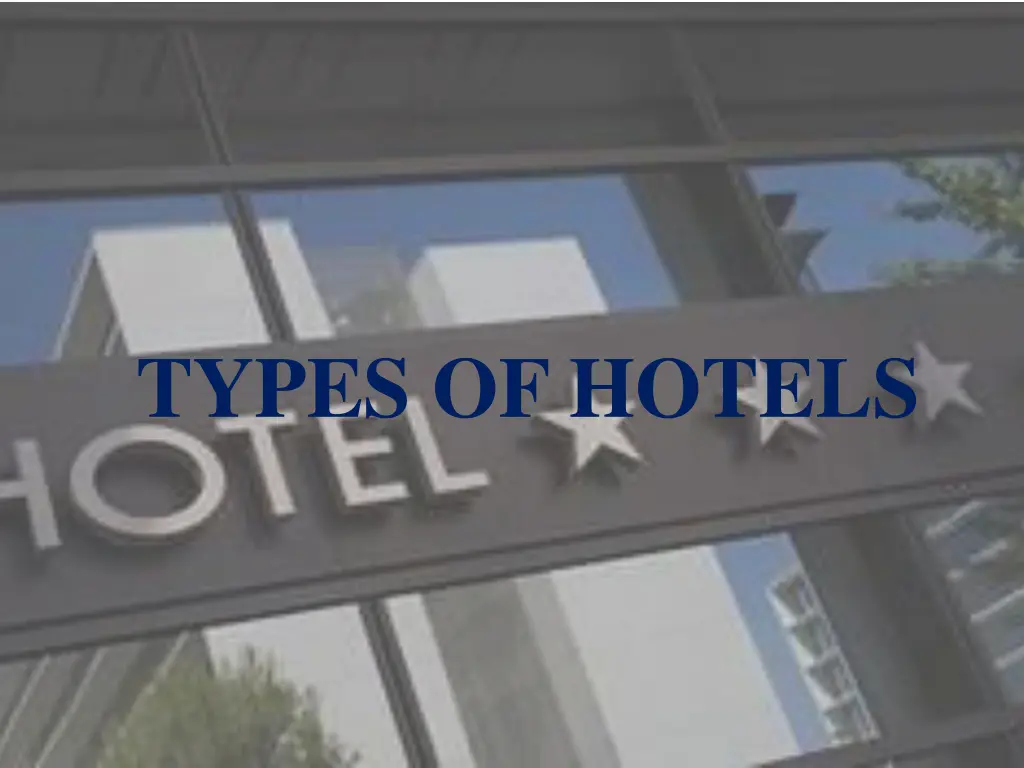
Different Types of Hotels and Their Amenities
Explore various types of hotels including resort hotels, airport hotels, economy hotels, and conference centers/commercial hotels. Learn about the unique features, amenities, and target clientele of each hotel type, from luxurious resort getaways to business-focused accommodation options.
Download Presentation

Please find below an Image/Link to download the presentation.
The content on the website is provided AS IS for your information and personal use only. It may not be sold, licensed, or shared on other websites without obtaining consent from the author. If you encounter any issues during the download, it is possible that the publisher has removed the file from their server.
You are allowed to download the files provided on this website for personal or commercial use, subject to the condition that they are used lawfully. All files are the property of their respective owners.
The content on the website is provided AS IS for your information and personal use only. It may not be sold, licensed, or shared on other websites without obtaining consent from the author.
E N D
Presentation Transcript
CONTENT 1. DIFFERENT TYPES OF HOTELS 2. STAR HOTEL RATING 3. TYPES OF HOTEL ROOMS
Resort hotels are frequented by the customer on vacation. They may feature amenities that will permit their clientele to relax and have fun. Popular amenities may include: spas, pools, beach or mountain locations, on-site kids activities, restaurants, pool bars and babysitting services. Concierges are often available to help patrons find restaurants or book sightseeing tours. Patrons often stay a week or more. Resort hotels, because of their many amenities, often attain high star ratings.
Airport hotels are designed to have clean rooms and are booked because of their close proximity to the airport. Often, they offer shuttles to and from the airport. Many airport hotels offer business amenities and restaurants for guests. Airport hotels may have a high turnover of guests staying for short durations of time, and are often located in cities.
Economy hotels provide limited amenities at reasonable rates. Sometimes, economy hotels provide guests with a complimentary continental breakfast. Economy hotels in resort areas may be off the beaten path, or in a slightly less desirable location. Economy hotels offer basic room accommodations, and many do not have full service on-site restaurants. More recently, some economy hotels have adjacent chain restaurants within walking distance, often sharing the same parking lot.
Conference centers and commercial hotels are designed for business clientele. Conference centers feature multipurpose rooms that can accommodate seminars and business programs. They have banquet facilities that can serve and accommodate large parties, and also offer equipment and acoustics suitable for speakers and visual presentations. Some conference centers and commercial hotels are located in resort areas, but they still focus on the business needs of clients and companies.
Suite hotels appeal to business people that prefer a separate work space or families that want one room, yet also want some room separation from children. They often feature multiple rooms, and may have a pull-out bed in addition to the main sleeping area. Suite hotels have a broad range of amenities, and can be classified as high as a luxury hotel, or as a basic economy hotel, depending on the location and the services offered
Hostels provide budget-oriented, sociable accommodation where guests can rent a bed, usually a bunk bed, in a dormitory and share a bathroom, lounge, and sometimes a kitchen. Rooms can be mixed or single-sex, although private rooms may also be available. Hostels are generally cheaper for both the operator and the occupants; many hostels have long-term residents whom they employ as desk clerks or housekeeping staff in exchange for free accommodation.
Amotel is a hotel designed for motorists and usually has a parking area for motor vehicles. Entering dictionaries after World War II, the word motel, coined as a portmanteau contraction of "motor hotel", originates from the Milestone Mo- Tel of San Luis Obispo, California (now called the Motel Inn of San Luis Obispo), which was built in 1925.The term referred initially to a type of hotel consisting of a single building of connected rooms whose doors faced a parking lot and in some circumstances, a common area or a series of small cabins with common parking. Motels are often individually owned, though motel chains do exist.
Overview of Criteria according to Star Ratings Australia Star Rating Properties that typify luxury across all areas of operation. Guests will enjoy an extensive range of facilities and comprehensive or highly personalised services. Properties at this level will display excellent design quality and attention to detail. Properties which achieve a deluxe guest experience. A wide range of facilities and superior design qualities are typically complemented by service standards that reflect the varied and discerning needs of the guest. Properties that deliver a broad range of amenities that exceed above-average accommodation needs. Good quality service, design and physical attributes are typically fit for purpose to match guest expectations. Properties that focus on the needs of price conscious travellers. Services and guest facilities are typically limited to keep room rates affordable and competitive but may be available upon request or fee-based. Properties that offer budget facilities without compromising cleanliness or guest security. Guests may access fee-based services or facilities upon request. Half-star ratings indicate modest improvements in the quality and condition of guest facilities.
